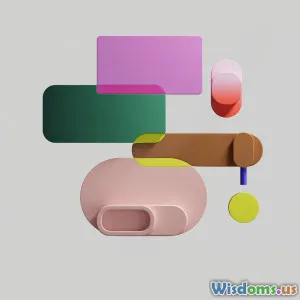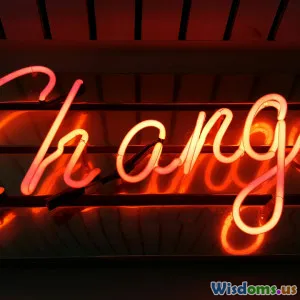
The Future of Design: AI and Creativity
7 min read Explore how AI is reshaping graphic design, blending technology with creativity to revolutionize the future of visual arts. (0 Reviews)
The Future of Design: AI and Creativity
In the rapidly evolving world of graphic design, artificial intelligence (AI) is no longer just a futuristic concept but an active force reshaping the limits of creativity. As AI technologies grow more sophisticated, they are opening unprecedented opportunities for designers, enabling a fusion of human imagination and algorithmic precision. This powerful synergy sparks innovation, streamlines workflows, and elevates design quality, heralding a new era where creativity and technology coalesce more seamlessly than ever before.
The Intersection of AI and Graphic Design
The dialogue between AI and design challenges the long-standing notion that creativity is an exclusively human domain. AI-powered tools analyze patterns, generate ideas, and even fabricate design elements from scratch with remarkable speed and adaptability. Yet, these innovations don’t render human designers obsolete. Instead, they enrich the creative process by acting as collaborators, assistants, and amplifiers.
AI as a Creative Partner
Software platforms like Adobe’s Sensei and Canva’s AI-powered tools illustrate how machines can elevate creativity. Adobe Sensei leverages machine learning to automate tasks such as image tagging, font recognition, and layout suggestions—allowing designers to focus on conceptual work rather than repetitive chores.
Canva’s Magic Resize feature uses AI to adapt designs to various formats in seconds, invaluable for the fluid demands of multi-platform marketing campaigns. This kind of assistance grants designers time for ideation and exploration, encouraging bolder artistic experimentation.
Generative Design: Beyond Human Imagination
Generative design algorithms have the unique ability to produce thousands of iterations based on specific input parameters. Autodesk’s Dreamcatcher system, initially applied in architecture and manufacturing, is inspiring graphic design by generating novel patterns and layouts that inspire human creators. For instance, designers can input brand colors, style preferences, and target demographics, and the AI outputs multiple visual concepts to explore.
Such tools don’t replace creative decision-making; they broaden the horizon of possibilities, offering fresh perspectives and designs that might not emerge through traditional brainstorming.
Data-Driven Creativity: The Power of Insights
AI's strength lies not only in generating visuals but also in digesting vast amounts of data to inform design choices strategically. Marketing teams integrate AI analytics to understand consumer preferences, engagement metrics, and cultural trends, enabling them to tailor visual content with pinpoint accuracy.
For example, Spotify uses AI to generate personalized playlists but also to craft unique cover art based on listening behavior and moods. These insights help designers create content that resonates on a more personal level, boosting engagement and authenticity.
Ethical Considerations and Challenges
The rise of AI in design prompts important ethical questions. Who owns AI-generated artwork? How do designers ensure originality when AI models learn from existing works? These issues are actively debated, as regulations and industry standards strive to keep pace with technological advances.
Moreover, overreliance on AI risks homogenizing creativity if designers default to AI-made templates without injecting unique human expression. To avoid this, intentional collaboration and critical oversight remain essential.
Real-World Impact on Graphic Design Careers
The integration of AI influences the graphic design profession profoundly. A recent survey by Adobe revealed that 64% of creative professionals believe AI allows them to be more innovative by reducing mundane workloads. Far from eroding jobs, AI is reshaping roles—designers increasingly become curators and strategists overseeing AI-generated outputs.
Educational curricula adapt accordingly. Institutions like the Savannah College of Art and Design (SCAD) incorporate AI tools in coursework to prepare students for a digitized design landscape, emphasizing how to harness AI creatively and ethically.
The Road Ahead: Embracing AI Creativity
The future of graphic design is vibrant and dynamic, shaped by a human-machine partnership. AI will continue to evolve, improving in understanding context, style, and cultural subtleties, potentially generating complex narratives and interactive media autonomously.
To thrive, designers must cultivate skills blending technical acumen with creativity — mastering AI tools while nurturing intuition and originality. Organizations willing to embrace these technologies will gain competitive edge through faster production cycles, personalized customer engagement, and innovative storytelling.
Inspiring Example: The Cannes Lions Festival
At the 2023 Cannes Lions International Festival of Creativity, several agencies showcased AI-driven campaigns that used machine learning to tailor ads in real-time, creating immersive experiences that adapted dynamically to audience reactions. This intersection of AI and live design demonstrates the vast, untapped potential awaiting exploration.
Conclusion
AI is not the future adversary of creativity but its powerful ally. In graphic design, it offers a catalyst for growth—helping break traditional boundaries while enhancing the innate human skill of visual storytelling. By embracing AI thoughtfully, creatives can unlock new dimensions of expression and innovation, transforming both their craft and the very notion of what it means to create.
The future of design is a collaborative canvas where human insight meets artificial intelligence, promising not only efficiency but exhilarating new creative frontiers.
Rate the Post
User Reviews
Popular Posts





















